

John Champeau interview
By Scott Stilphen
(2006)
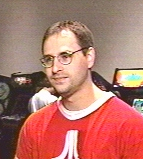
ďWhatís in a name?Ē Shakespeare put forth the question some 400 years ago, but had he lived amongst us today, he might well have asked, ďWhatís in a game?Ē If you were a PC gamer in the mid to late-90s, you were probably aware of CHAMProgramming and their line-up of incredibly accurate arcade translations. In fact, John Champeauís games were so accurate, they attracted the attention of companies like Atari and Namco, who wasted no time in showing their ďappreciationĒ. Thankfully, he didnít hang up his programming gloves forever; 2005 saw the reincarnation of CHAMProgramming (as Champ Games) and heís just as devoted to create arcade-perfect translations Ė only this time for the VCS! I put 20 questions to the latest programming Ďchampí to hit the Atari 2600 scene, in an effort to find out whatís in his games that makes them so damn good!
Q: Whatís your educational background?
John Champeau: My educational background is a computer science and engineering degree from the University of Connecticut. My game programming background is mostly self-taught Ė I must have bought every game-programming book that came out in the early 90ís.
Q: What inspired you to go into game design?
John Champeau: In the early 80ís my mom bought us an Atari 800. We had been playing the VCS since 78, and the games on the 800 were even better. After a few months I discovered BASIC, and started writing some simple games. This was a huge creative outlet and soon I was spending many nights (sometimes all night) writing games, including a Karate game and a Wizard of Wor-type game.
Q: Were there any programmers or games that inspired you?
John Champeau: I was not aware of any programmers, but I must say that the VCS games and early arcade games were my first inspiration. My friend Dennis and I would spend our free time designing games that we thought would make great 2600 titles. One game we designed was called Mountain Raider. This game can best be described a combination of Scramble, Berzerk and H.E.R.O. The design was even sent to Atari, although it was rejected.
Q: Before MAME got popular, your arcade PC versions were the next best thing to having the actual machine! Whatís the history of CHAMProgramming?
John Champeau: The story of CHAMProgramming started in the early 90ís. VGA graphics had just become available, and the 320x200 256 color mode was quite easy to work with since it was a linear buffer. Almost immediately I started writing a sequel of Missile Command called Last Defense. The game was finished and featured power-ups, shields, and different weapons with the same basic play of Missile Command.
Around this time, AOL had become popular and I started downloading shareware games. Most were based on the classics like Asteroids, Pac-Man, and Space Invaders. None of them, unfortunately, seemed to capture the spirit of the originals, so I was determined to make my own versions.
My first shareware game was Pacmaniac - a Pac-man clone based on the Atari 800 version. When I got my first $10 check in the mail, I was ecstatic! This led to Ms. Pac-man, Galaxian, Asteroids, and Centipede being developed. All games were still shareware, uploaded to the AOL game section and a few checks would come in every so often.
At this point, I had sharpened my programming skills and took on one of my favorites - Donkey Kong. With this new game I decided to dive into the Internet as well and set up my own web page where I could post news, shareware downloads, and have a central point where people could post feedback and buy the games. I decided to use part of my last name and call this new game CHAMP Kong. With this new game, I also spent time adding in other game related enhancements, like a common user interface, high scores, a side bar with graphics, a nice title screen, sound card support, game instructions, and support for controllers, including a regular Atari joystick through the CHAMP Cable. This was a cable that connected to the parallel printer port and allowed the player to use an Atari joystick to play the game. It was pretty cool! The biggest addition, however, was including a CHAMP mode with the game. This mode was similar to the arcade mode, except it would have different levels and power ups.
Q: Did anyone else help you with the games, or were they a solo effort?
John Champeau: To help with the business, my then-girlfriend (and now wife) Christina joined to help with filling orders and my brother Paul joined to head the hardware and testing department. I also employed a graphic artist and a sound effects expert as these were usually the most time consuming pieces of games design.
Q: What was your most popular title?
John Champeau: CHAMP Kong was a huge hit, selling many copies. From there, the comment mailbox starting filling up with suggestions of other games we should make. The first task I wanted to do was re-release the original five games with the new game engine and features, as well as add a CHAMP Mode. So, the next few months saw the release of CHAMP Ms. Pac-em, Pac-em, Galaxia, Asterocks and Centiped-em. All were met with a positive response and things were going well.
Q: Why did the company shut down?
John Champeau: The first bad news hit CHAMProgramming in October of 1997 with a cease-and-desist from JTS Corporation, the company who held the rights to Atari at the time. Although there were dozens of Asteroid and Centipede clones out, apparently our versions were a little too good and needed to be removed from the website. Game development continued, with the release of CHAMP Invaders and CHAMP Galagon. CHAMP Frog-em and CHAMP Burger Climb were both in development in July of 1998 and about 50% completed when a C&D was received from Namco. Removing the Namco titles from our catalog left us with only CHAMP Kong and Invaders, and the decision to shut down CHAMProgramming was made on August 3rd.
Q: With your games, were there any features you would have liked to have added, or any known bugs or glitches that gave you trouble (or never got resolved)?
John Champeau: We spent many hours designing our games, including the game play and the user interface. At the time CHAMProgramming was shut down, I was developing a new game engine that would have allowed us to created games for DOS and Windows concurrently. We were also looking into using higher-resolution modes for vector games and using the Internet for an online hi-score list for our games (similar to the Xbox Live Arcade). One major project we were designing was a Ďvirtual arcadeí that would have allowed people to play our games online against other people over the Internet. The arcade would have had built-in games like foosball, pinball, skee-ball, air hockey, etc. and allowed players to add CHAMP games too.
I donít know of any known bugs, but the sound driver we used seemed to be pretty buggy. We did have a few service releases of our games if any major bugs were found.
Q: Now that CHAMProgramming has been Ďreborní as CHAMP Games, itís clear the same level of quality and faithfulness to your ports continues. Why choose such a limited platform like the VCS to program on? And do you have plans to program for other systems?
John Champeau: I chose the VCS to get back into game programming for a few reasons. First, it is my favorite video game console and the one that I have the fondest memories of. Second, I have always wanted to make a game for the system, starting way back in 1982 with Mountain Raider. Third, the limited platform of the VCS offers a unique challenge that I wanted to tackle. Although I seem to have a list a mile long of games I want to do for the VCS, eventually I would love to make a real game for the 8-bit line and perhaps rewrite some of the BASIC games I made in the early 80ís, but this time write them in Assembler.
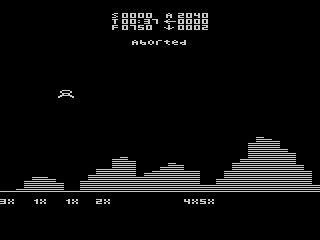
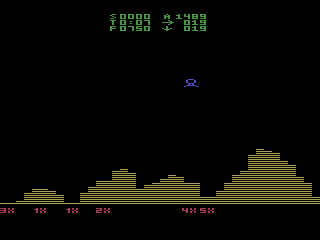
Champeau did a much-improved version (RIGHT) of the Flashback 2ís nearly-unplayable Lunar Lander (LEFT),
and even included an option for color while cutting the ROM size in half!
Q: How did you come to work on some of the Flashback 2 games?
John Champeau: I was impressed with the FB2 overall but very disappointed in some of the new games - especially Caverns of Mars. I wrote to Curt Vendel and asked if I could help in improving them. After a few exchanges it appeared that a Rev. C of the FB2 was in the works so he had me try to "fix" a few of the games. My first project was to try to reduce the # of scan lines in the GCC version of Millipede; unfortunately, the game was PAL and too much game logic would cause the screen to roll. Up next was an opportunity to fix the constant flickering in Lunar Lander. For this project, I was given the ROM (which I disassembled since he didnít have the source code) and tried to follow what was going on. This proved to be too difficult, so I spent the next couple of weeks rewriting the game from scratch while retaining the look of the original FB2 version. Once this was completed, I offered to try my hand at doing a new Caverns of Mars. Lunar Lander was my first complete 2600 game, so taking Caverns of Mars seemed a little overwhelming, but after a few days I was able to deliver a proof-of-concept that showed that the game could look and play almost exactly like the Atari 800 version. After a few months, the game was completed and Curt waited for Atari to give the go-ahead for the FB2 Rev C. Unfortunately, the FB2 Rev C project was altered and the updated games (including a fixed version of Arcade Pong that I did, and one of Yars' Return that was done by Dennis Debro) were not included. On a brighter note, I still owned the code so I took the time to rework the Caverns of Mars engine to a similar game called Conquest of Mars, which was released a few months later.

Like Lunar Lander, the FB2ís Caverns of Mars (LEFT) is a flickering mess, and not very faithful to the original (RIGHT).

As with his Lunar Lander, Atari/Legacy Engineering failed to include the new Caverns of Mars (LEFT).
Thankfully Champeau went ahead and released it as Conquest of Mars (RIGHT).
Q: Your port of Caverns of Mars is very faithful to the Atari 400/800 version. Iíve always found the original to be too easy, but yours is quite a challenge!
John Champeau: I've tried to address a few things in the 800 version of Caverns of Mars that always bugged me. The ship explosion was one of them; the other was the escape sequence. It seems to get impossible the 2nd time around, and if you crash anywhere in it, your game is basically over (you usually only get enough time to get out without crashing). Both have been addressed in this version. Also, I have a 2-player option, 2 cavern layouts for each stage, new laser gate patterns, a survival bonus for reaching the base without getting killed, a timer bonus for each second left after you escape, and a continue feature. Also, the difficulty switches adjust your fuel consumption rate. Heck - I even threw in a nice ending to the game if you're good enough to clear all 6 levels.
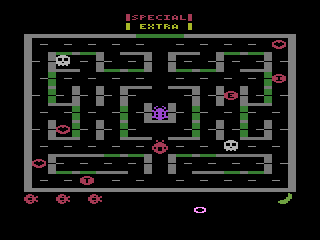
Q: What was your reason for porting Lady Bug?
John Champeau: After finishing my work for the FB2, I wanted to use my new-found knowledge of 2600 programming to port a sentimental favorite of mine from back in the 80's. One game that I had thought about porting was Universal's Lady Bug - a game similar to Pac-man but with enough twists and turns to make it a stand-out game of its own. I always had fond memories of the game and enjoyed playing it back in the day on my friend's Colecovision. This game was one of only two games my mother played back then (the other was Pac-man), so I dedicated the 2600 version to her memory. And of course, Digital Pressí April Fool's joke a few years back that claimed the Coleco version had been found only inspired me more to prove that a good version of Lady Bug could be made for the Atari!
Q: Besides being a stellar port of the arcade version, Lady Bug incorporates a ďfirstĒ for a VCS games Ė itís the first to reproduce the 'start up' sequence (ROM/RAM tests)!
John Champeau: Thanks! I'm glad you like it. I think it adds to the authenticity of the port in a small way. That idea was actually given to me by Nathan Strum, who also did the amazing graphics for the game, as well as the label and manual. Also, I would like to give huge credit to Bob DeCrescenzo for his fantastic sound effects and music that he was able to reproduce on the 2600.
Q: Few homebrew VCS programmers have mastered the system seemingly as fast as you have. How much of your experience with CHAMProgramming do you attribute to your quick learning curve?
John Champeau: I would have to give most of the credit to two things. One is my experience with Assembler that I obtained in my Operating Systems class at UCONN back in 1990. The second is my experience with game programming. Many of the algorithms or approaches I used with Conquest of Mars or Lady Bug were very similar to my coding style used in the CHAMP games. Although the CHAMP games were on a PC, we always tried to make them as efficient as possible so that they could run on minimal memory and PC hardware. For example, all of my graphic routines in the CHAMP games were written in Assembler.
I must give most of the credit, however, to the Stella list, which is a group of Atari 2600 programmers that exchange ideas. I have been reading their posts since I discovered it back in 2001. The lessons learned from those pioneers and the inspiration that I got from seeing their games finished were invaluable. The Atari community continues to help homebrew authors any chance they can, whether itís a suggestion on game play, a better algorithm, or just flat-out game testing.
Q: Are there Easter eggs in any of your titles?
John Champeau: Yes, I believe all of my games have at least one Easter egg or cheat, although Iím not going to give any hints. ;)
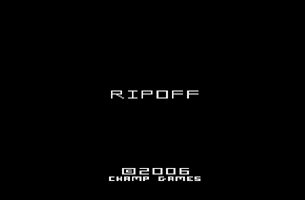
Q: You mentioned your currently working on a port of Rip Off. What future plans do you have beyond that?
John Champeau: Rip Off is about 50% done right now and I hope to have a playable demo ready by VGXPO in October. Once that is complete, I have tons of ideas for 2600 games that I want to pursue. One priority is to finish a hockey game (tentatively called Championship Hockey) that I started 4 years ago. With the experience Iíve gained doing my other games, I may be able to do this one justice. Another priority is an action adventure game that Iíve designed based on the Milton Bradley board game called Dark Tower. Of course, I have many little side projects as well, such as a rewrite of Wizard of Wor that Iím about 50% finished with, as well as finishing the Elevator Action prototype that was released a few years ago (I have the source code about 60% labeled). There are many other ports I wouldnít mind doing as well, like Mappy, Zoo Keeper, and Scramble to name a few. Looks like Iím going to be busy for a while!
Q: If you had a chance to redo any of your games, what would you change (if anything)?
John Champeau: Well, my 2600 games are pretty much the way I want them to be, although it would have been nice to squeeze in MemCard support for high scores; I just didnít have the space. The CHAMP games were all slated for an update with the new game engine I was designing, which would have added DirectX support, higher-resolution graphic modes, and integrated Internet connectivity for registration, updates, trial versions of other games, and online high score support.
A few CHAMP games that were in development but never got past the proof-of-concept stage that I would have really loved to complete were Lunar Patrol (Moon Patrol) and Tutank-em (Tutankham). I had written a pretty slick engine that did parallax scrolling and 4-way scrolling and the demos of these games were pretty stunning.
Q: Itís clear youíre a fan of classic video games. Have you ever thought about doing work for a company like Jakks? What about designing cell phone games, as many former VCS programmers have done?
John Champeau: That would be interesting. Right now, I enjoy doing non-video game related work for my real job. For example, with my last job I was the lead programmer for a real-time credit card fraud detection system. I did just start a new job that is
involved in video games from an 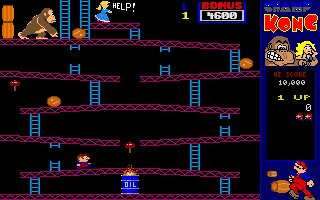 advertising standpoint, and one of my first tasks is to write a game for the PocketPC. Who knows, maybe Iíll end up doing something like cell phone
games after all!
advertising standpoint, and one of my first tasks is to write a game for the PocketPC. Who knows, maybe Iíll end up doing something like cell phone
games after all!
Q: Which of your titles are your favorite, and what types of games in general?
John Champeau: My favorite CHAMP game is probably CHAMP Kong, especially in CHAMP mode. Classic games are obviously my favorite; the games I play the most are usually shooting games like Galaga, Asteroids, and Centipede, although I love a game of Pac-man/Ms. Pac-man every now and then.
Q: Lastly, now that youíre capable of designing most any VCS game you want, will Mountain Raider finally become a reality? ;)
John Champeau: Yes. My most-important goal is to bring to fruition my original Atari game :). Mountain Raider will be done for the 2600 sooner than later. Iím still looking through my archives, trying to dig up the original designs (although I know the design by heart, even after all these years).
Check out John's Champ Games site. To learn more about CHAMProgramming, check out Manfred Kremerís site.
| GAME | SYSTEM | COMPANY | STATUS |
| CHAMP Asterocks | PC | CHAMProgramming | released |
| CHAMP Asteroids | PC | CHAMProgramming | released |
| CHAMP Basketball | PC | CHAMProgramming | unreleased |
| CHAMP Berzerker | PC | CHAMProgramming | unreleased |
| CHAMP Burger Climb / Burger Chef | PC | CHAMProgramming | unreleased |
| CHAMP Centipede | PC | CHAMProgramming | released |
| CHAMP Centiped-em | PC | CHAMProgramming | released |
| CHAMP Defender | PC | CHAMProgramming | unreleased |
| CHAMP Frog-em | PC | CHAMProgramming | unreleased |
| CHAMP Galagon | PC | CHAMProgramming | released |
| CHAMP Galaxia | PC | CHAMProgramming | released |
| CHAMP Galaxian | PC | CHAMProgramming | released |
| CHAMP Invaders | PC | CHAMProgramming | released |
| CHAMP Joust | PC | CHAMProgramming | unreleased |
| CHAMP Joust-em | PC | CHAMProgramming | unreleased |
| CHAMP Kong | PC | CHAMProgramming | released |
| CHAMP Kong Jr. | PC | CHAMProgramming | unreleased |
| CHAMP Lady Bug-em | PC | CHAMProgramming | unreleased |
| CHAMP Lunar Patrol | PC | CHAMProgramming | unreleased |
| CHAMP Missile Command 1 & 2 | PC | CHAMProgramming | unreleased |
| CHAMP Missile Commander | PC | CHAMProgramming | unreleased |
| CHAMP Ms. Pac-Man | PC | CHAMProgramming | released |
| CHAMP Ms. Pac-em | PC | CHAMProgramming | released |
| CHAMP Pac-em | PC | CHAMProgramming | released |
| CHAMP Q*Bit | PC | CHAMProgramming | unreleased |
| CHAMP Star Fortress | PC | CHAMProgramming | unreleased |
| CHAMP Super Pac-em | PC | CHAMProgramming | unreleased |
| CHAMP Tutank-em | PC | CHAMProgramming | unreleased |
| Last Defense | PC | CHAMProgramming | unreleased |
| Pac-Maniac | PC | CHAMProgramming | released |
| Archon | Atari VCS/2600 | CHAMP Games | not completed |
| Avalanche | Atari VCS/2600 | CHAMP Games | released |
| Champ Sports Baseball | Atari VCS/2600 | CHAMP Games | not completed |
| Champ Sports Basketball | Atari VCS/2600 | CHAMP Games | not completed |
| Champ Sports Tennis | Atari VCS/2600 | CHAMP Games | not completed |
| Championship Hockey | Atari VCS/2600 | CHAMP Games | not completed |
| Conquest of Mars (aka Caverns of Mars) | Atari VCS/2600 | CHAMP Games | released |
| Cosmic Avenger | Atari VCS/2600 | CHAMP Games | not completed |
| Dark Towers | Atari VCS/2600 | CHAMP Games | not completed |
| Elevator Agent | Atari VCS/2600 | CHAMP Games | released |
| Galagon | Atari VCS/2600 | CHAMP Games | released |
| Gorf Arcade | Atari VCS/2600 | CHAMP Games | released |
| Lady Bug | Atari VCS/2600 | CHAMP Games | released |
| Lady Bug Arcade | Atari VCS/2600 | CHAMP Games | released |
| Lady Bug Collector's Edition | Atari VCS/2600 | CHAMP Games | released |
| Lady Bug NWCGE 2K7 | Atari VCS/2600 | CHAMP Games | released |
| Lunar Lander | Atari VCS/2600 | CHAMP Games | released |
| Mappy | Atari VCS/2600 | CHAMP Games | released |
| Moon Cresta | Atari VCS/2600 | CHAMP Games | not completed |
| Mountain Raider | Atari VCS/2600 | CHAMP Games | not completed |
| Qyx | Atari VCS/2600 | CHAMP Games | released |
| Rip Off | Atari VCS/2600 | CHAMP Games | released |
| Robot War: 2684 | Atari VCS/2600 | CHAMP Games | released |
| Scramble | Atari VCS/2600 | CHAMP Games | released |
| Super Cobra Arcade | Atari VCS/2600 | CHAMP Games | released |
| Turbo Arcade | Atari VCS/2600 | CHAMP Games | released |
| Tutankham Arcade | Atari VCS/2600 | CHAMP Games | released |
| Wizard of Wor Arcade | Atari VCS/2600 | CHAMP Games | released |
| Zoo Keeper | Atari VCS/2600 | CHAMP Games | released |